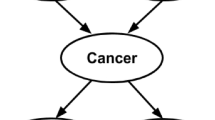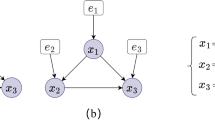Abstract
A Bayesian network (BN) is a probabilistic graphical model that represents random variables of causal relationships as a directed acyclic graph. There are many methods to construct BNs. These methods decide a BN structure whose likelihood is best in candidates. However, the edges expressing causal relationships tend not to match the one manually obtained by a human, because it reflects the causality between events that do not occur. We should focus on causal relationship of events that occurs in the most of cases. Therefore, it is convenient to generate a BN based on causal chains. To generate a BN from causal chains, we propose an approach to get events and causal chains from diagnostics reports and infer events by using BN. Since causal chains in the report are definitive, probabilities in BNs can be limited to zero or one. Thus, we also propose a simplified algorithm for BN inference.
Access this chapter
Tax calculation will be finalised at checkout
Purchases are for personal use only
Similar content being viewed by others
References
Kazuo, S., Youiti, M., Saneomi, U.: Outline of Bayesian Network. Baifukan, Japan (2006)
Brown, L.E., Tsmardinos, I., Aliferis, C.F.: The max-min hill-climbing Bayesian network structure learning algorithm. Mach. Learn. 65, 31–78 (2006)
Daisuke, I., Masaomi, K.: Method to identify deep cases based on relationships between nouns, verbs, and particles. In: International Conferences ITS, ICEduTech and STE 2016, pp. 43–50, Australia (2016)
Hisakazu, O., Tethuyuki, T.: Introduction of Boolean Mathematics of Information Science. Kindaikagakusya, Japan (1999)
Acknowledgements
The authors would like to thank Tribotex Co., Ltd. for supporting this research.
Author information
Authors and Affiliations
Corresponding author
Editor information
Editors and Affiliations
Rights and permissions
Copyright information
© 2018 Springer International Publishing AG
About this paper
Cite this paper
Ueda, Y., Ide, D., Kimura, M. (2018). Bayesian Network Construction and Simplified Inference Method Based on Causal Chains. In: Karwowski, W., Ahram, T. (eds) Intelligent Human Systems Integration. IHSI 2018. Advances in Intelligent Systems and Computing, vol 722. Springer, Cham. https://doi.org/10.1007/978-3-319-73888-8_68
Download citation
DOI: https://doi.org/10.1007/978-3-319-73888-8_68
Published:
Publisher Name: Springer, Cham
Print ISBN: 978-3-319-73887-1
Online ISBN: 978-3-319-73888-8
eBook Packages: EngineeringEngineering (R0)




